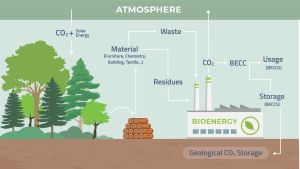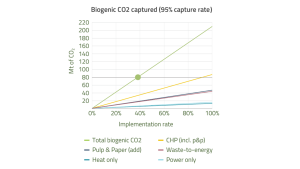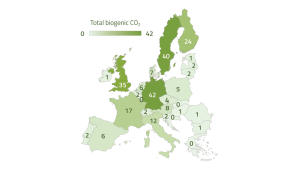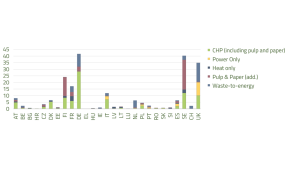‘Bioenergy Europe’ explains how bioenergy with carbon capture and storage can hold the key to Europe’s energy transition.
Achieving net-zero greenhouse gas emissions by 2050 remains one of the European Union’s most difficult challenges. Reducing fossil fuel emissions is essential, but the latest scientific evidence and policy modeling converge on the important conclusion that carbon dioxide removal (CDR) must complement emissions reductions to achieve climate neutrality. Upcoming changes to EU climate law will bring the industrial waste debate back to the forefront, raising awareness that durable and verifiable carbon removal technologies are essential to achieving Europe’s long-term goals.
BECCS: A proven route to carbon-negative energy
Bioenergy with carbon capture and storage (BECCS) occupies a unique position within the CDR portfolio. It combines renewable bioenergy from sustainably managed biomass with technology to capture and permanently store biogenic CO₂ emissions. The underlying principles are rooted in the natural carbon cycle. As biomass grows, CO₂ is removed from the atmosphere through photosynthesis. When that biomass is used to generate energy, it can effectively capture carbon from the atmosphere on a net basis by capturing and storing emitted CO₂.

Unlike many negative emissions concepts that are still in development, BECCS is based on commercially mature technology that is already deployed in multiple industrial settings. The dual benefits of providing renewable energy and achieving permanent removal make it one of the few scalable solutions that can provide short-term climate benefits while supporting Europe’s decarbonization and energy security goals.
Quantifying the potential: 80 million tons of CO₂ by 2040
The European Commission’s Impact Assessment Report on 2040 climate targets and the path to climate neutrality by 2050 estimates that 80 million tonnes (Mt) of industrial CO₂ removal will be needed per year by 2040 to stay on track towards net zero. A recent study by BEST – Bioenergy and Sustainable Technologies GmbH shows that this goal is not only realistic but achievable with existing assets.

According to the study, by retrofitting just 38% of existing biomass facilities with BECCS, the EU could already reach its 2040 target. Expanding deployment to 50% of current facilities could permanently remove approximately 150 million tonnes of CO₂ per year. These figures show that Europe’s industrial carbon removal goals are technically achievable, once enabling conditions are established.
Build on established frameworks
The EU has already taken important steps to create a supportive policy environment. The Renewable Energy Directive (EU/2023/2413) strengthens biomass sustainability and greenhouse gas performance standards (Article 29) and provides a solid governance foundation for integrating BECCS into existing renewable energy frameworks. Many bioenergy plants operate near large industrial clusters or coastal CO₂ storage sites, making retrofitting carbon capture systems a cost-effective and rapid implementation route.
The learning curve is expected to drive costs down further as experience accumulates and transportation and storage infrastructure expands, mirroring trends seen in wind and solar over the past decade. Co-locating biomass power or CHP facilities within industrial clusters creates opportunities for shared CO₂ networks, waste heat utilization, and joint logistics, further improving project economics.
Remove policy and fiscal barriers
Despite being technically ready, BECCS implementation remains constrained by regulatory and financial fragmentation. Project developers face complex permitting, unclear eligibility rules, and patchy access to funding. Addressing these obstacles is essential to unlocking the potential of this field.
The first step to unlocking the potential of BECCS is to ensure predictable and consistent implementation of existing EU law and avoid regulatory uncertainties that hinder investment. Financing schemes should be simplified and targeted measures introduced to de-risk early projects, for example through contracts for difference and carbon removal purchase agreements.
In parallel, the development of a harmonized EU certification framework for carbon removal, the Carbon Removal and Carbon Agriculture Regulation (CRCF), represents significant progress. The CRCF lays the foundation for reliable and tradable carbon removal credits by defining transparent accounting methodologies and monitoring, reporting, and verification (MRV) standards. Although improvements are needed, the comprehensive process established a solid scientific and policy baseline. Early adoption is critical to providing the long-term certainty investors seek.
Infrastructure: the backbone of scale
Even the most efficient capture technology cannot achieve removal without reliable CO₂ transport and storage infrastructure. The absence of an integrated pipeline network and accessible underground storage remains a bottleneck for large-scale deployment. Prioritizing shared CO₂ transport and storage hubs, particularly within industrial regions such as the North Sea Basin, the Baltic Sea and the Mediterranean Corridor, will significantly reduce costs through economies of scale.

Public-private partnerships are essential to developing this infrastructure, with clear accountability and transparent permitting procedures. Ensuring interoperability with future carbon transport networks under initiatives such as the TEN-E regulation will further support a single European market for captured carbon.
National action and public engagement
While EU-level policy sets the direction, Member States must play a decisive role in implementation. Integrating BECCS implementation goals into the National Energy and Climate Change Plan (NECP) will help mobilize domestic resources, coordinate infrastructure planning, and attract private investment.
Equally important is the social aspect. Public awareness of BECCS remains limited, and misconceptions about biomass sustainability persist. Transparent communication and education efforts are essential to building trust. Demonstrating that BECCS uses sustainably sourced residues and by-products, rather than raw materials that compete with food or biodiversity, will help ensure public acceptance and policy sustainability.
Distinguish between permanent removal and emission reduction
As Europe designs its post-2030 climate architecture, it will be important to set separate targets for permanent carbon removal apart from aggregate emissions reductions. This “equality” principle ensures that fossil fuel CO₂ emissions are only offset by durable storage solutions, maintaining environmental integrity and preventing double counting. Recognizing BECCS as a dedicated category for industrial carbon removal is consistent with this approach and supports the credibility of corporate and national net-zero claims.

Carbon negative theory based on science
From a carbon accounting perspective, the climate benefits of BECCS derive from the biogenic origin of carbon. During biomass growth, CO₂ is absorbed from the atmosphere and stored in organic matter. When that same carbon is later captured and stored in geological formations over centuries or millennia, the overall result is a net carbon removal.
This process is fundamentally different from traditional carbon capture from fossil sources, which simply prevents new emissions. Life cycle assessments (LCAs) have consistently shown that if the biomass feedstock complies with EU sustainability standards, BECCS can achieve net negative emissions of between 700 and 900 kg of CO₂ per MWh of electricity or heat produced, depending on capture efficiency and storage persistence.
Additionally, BECCS installations can complement intermittent power sources such as wind and solar and contribute to grid stabilization by providing transmittable renewable energy. The dual capabilities of reliable renewable energy and durable carbon removal position BECCS as a foundational technology for resilient, low-carbon energy systems.
Deliver results with existing assets
The quantitative results of the BEST study demonstrate a practical reality. This means Europe won’t need to build entirely new facilities to meet its removal goals. By upgrading around a third of its current biomass capacity, the EU could achieve the envisaged 80 million tonnes of CO₂ year-¹ in 2040. Expanding deployment to half of the facility would result in approximately 150 million tonnes of CO₂ year-¹ emissions, providing a significant margin of safety to meet climate goals.
These predictions assume mature capture technology, an average capture efficiency of >90%, and access to adequate storage capacity, conditions that are already achievable in Europe today. They confirm that large-scale BECCS implementation is not a distant future, but a near-term economic and policy challenge.
A practical and immediate solution
Among the available carbon removal options, BECCS stands out for its responsiveness, scalability, and cost-effectiveness. This leverages Europe’s strong bioenergy infrastructure and technical expertise and can be implemented using existing industrial assets and supply chains.
By supporting BECCS through a consistent policy framework, predictable certification and dedicated infrastructure, the EU can close the gap between ambition and implementation. Doing so will reaffirm Europe’s leadership on climate change, strengthen industrial competitiveness and make a decisive contribution to the 2040 carbon removal target.
In short, BECCS is not just a concept, but a proven, science-based solution that turns renewable energy into a negative emissions vehicle. With strategic alignment and investment, Europe can transform today’s bioenergy fleet into tomorrow’s carbon-negative power system, combining sustainability, security and technological leadership on the path to climate neutrality.
This article will also be published in the quarterly magazine issue 24.
Source link

